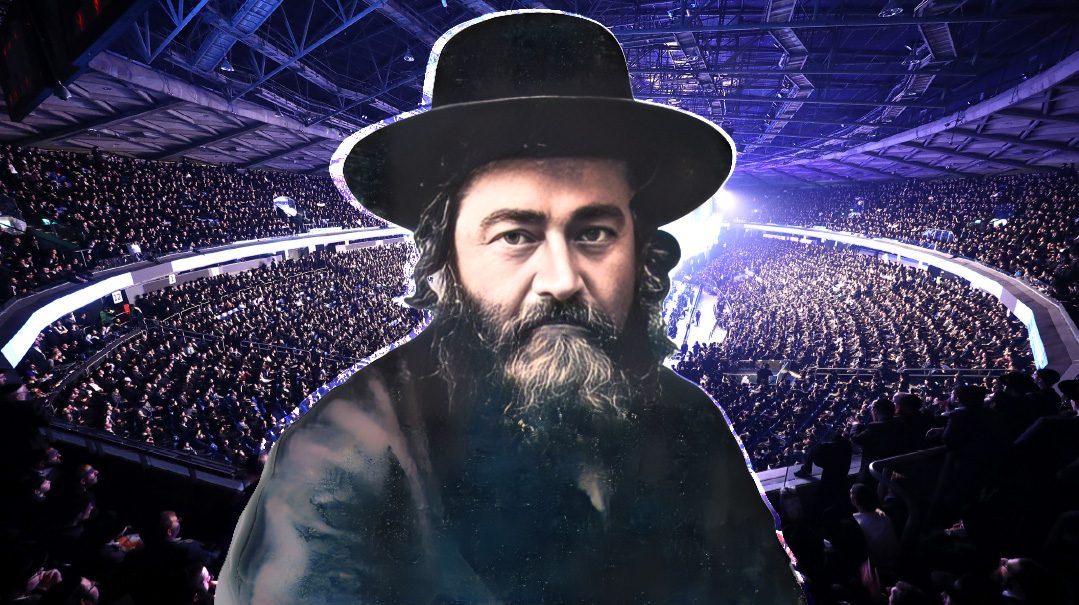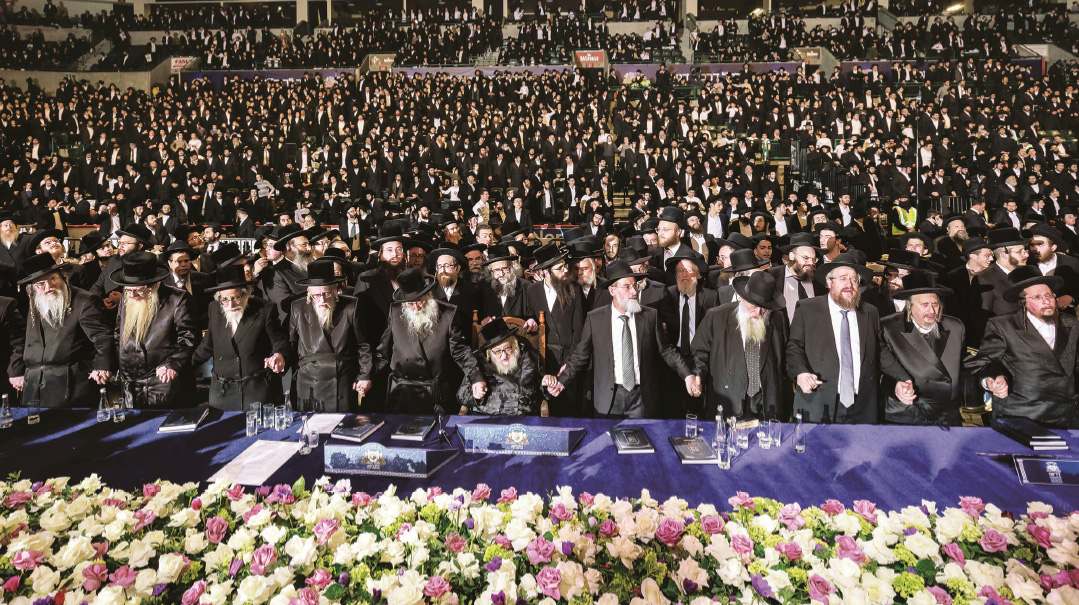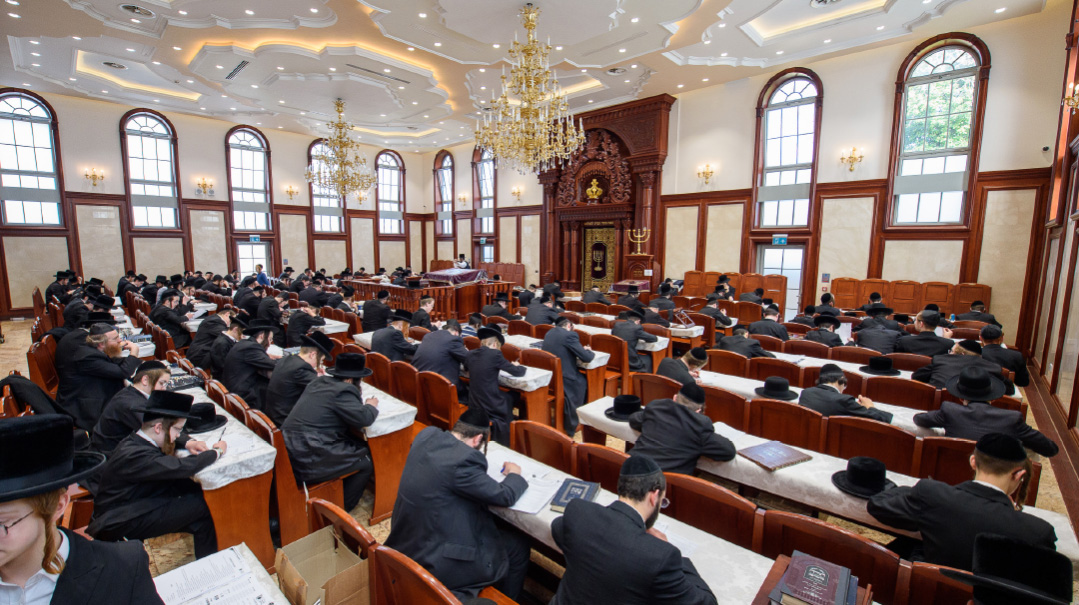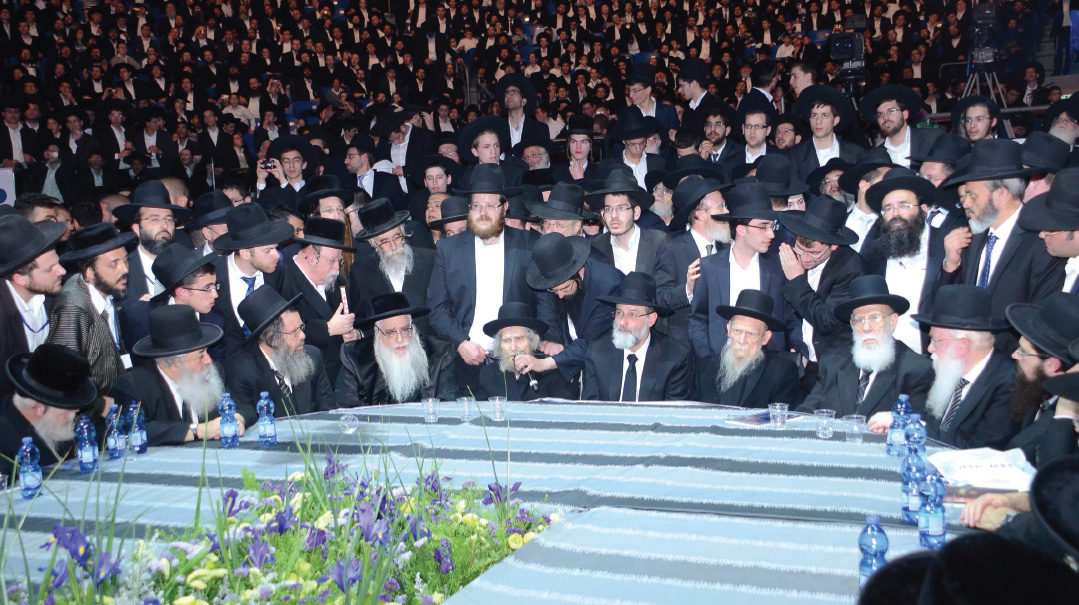Turning the Page

While the last century has seen turbulent change, Daf Yomi has remained a constant anchor

Photos: Dirshu archives
It’s been a hundred years since the first Knessiah Gedolah of Agudas Yisrael, where Rav Meir Shapiro presented his groundbreaking proposal to unite Klal Yisrael in learning the same page of Gemara daily. And while the last century has seen turbulent change, Daf Yomi has remained a constant anchor.
Daf Yomi accompanied the Jewish People through the horrors of the 20th century. Shattered survivors in displaced persons camps clung to the daf, which was often the only remaining link to their previous lives. Over the ensuing generations, the phenomenon grew and expanded, spawning a wide array of shiurim and other initiatives. Today, Daf Yomi shiurim are as diverse as they are ubiquitous, delivered by Talmudic scholars ranging from prominent rabbanim to businessmen and taking place in shuls, batei medrash, corporate boardrooms, and even commuter trains and cruise ships.
The past century has also witnessed many technological developments, many of which have been mobilized to disseminate the daf. Dial-a-Daf in America and Kol Daf in Israel made Daf Yomi available by telephone. The Dafyomi Advancement Forum created a website featuring many resources for Daf Yomi students.
Over the past quarter of a century, organizations and programs like Dirshu, ArtScroll/Mesorah, Agudath Israel of America’s Ki Heim Chayeinu, Shas Illuminated, and OU’s All Daf have done much to advance the Daf Yomi learning experience. Email and other digital media were tapped for Daf Yomi as well, and online shiurim by maggidei shiur like Rabbis Sruli Bornstein, Shalom Rosner, Eli Stefansky, Moshe Elefant, and Aryeh Lebowitz have also gained considerable traction. The increase in crowd size at each successive Siyum HaShas attests to the increasing force of the phenomenon.

Lavish landmark events drive home the message that no one deserves kavod more than bnei Torah. At the Dirshu World Siyum, 2022
In the Yeshivah’s Walls
“Rav Meir Shapiro planted the seeds for some of the basic elements of the Torah world today,” explains Rabbi Dovid Hofstedter, the founder of Dirshu, a global organization that arranges many varied programs and initiatives to increase Torah learning. “For instance, he created the model of the contemporary yeshivah, which provides its bochurim with food and accommodations. Until his time, a yeshivah was a place where students could learn, but they had to provide for their physical needs on their own. The yeshivah world as it exists today is built on his model.
“The same is true of Daf Yomi,” Rabbi Hofstedter continues. Daf Yomi features prominently among Dirshu’s programs, and Rabbi Hofstedter sees his organization’s work as part of a historic process firmly rooted in Rav Meir Shapiro’s legacy.
“Rav Meir created the foundations for today’s Daf Yomi phenomenon when he introduced his vision of a program of learning that would unite all of Klal Yisrael. It was the job of later generations to take his idea and expand it, develop it, and build on it. The institution of Daf Yomi has given rise to an incredible degree of creativity, impelling many people to spearhead new shiurim and testing programs, to write new seforim, and to conduct siyumim. We are fortunate to be a part of that process.”
Rabbi Hofstedter was inspired to lay the groundwork for what would evolve to become the Dirshu movement when he branched out on his own in the Toronto real estate market in 1993. He’d noticed how many of his contemporaries, who’d once learned enthusiastically in yeshivah and then kollel, lost the momentum once they entered the business world.
“When I moved into my own offices, I wanted to have a beis medrash for people who were working,” he recalls. “The idea was to offer chavrusas and a shiur, followed by davening and coffee.”
A downtown office with a beis medrash was a new idea, but the real innovation he offered was a monetary incentive for working men. “It wasn’t a tremendous amount of money, but it was just enough to give people that push,” he recalls.
Dirshu’s Daf Yomi program launched in early 2004, with the goal of dramatically increasing the quality of the study of the daf, which was once considered a more superficial limud. Their detailed program, complete with tests and incentives, enables participants to master and retain the material on a deep level.
“This is part of our effort to develop Rav Meir Shapiro’s vision,” Rabbi Hofstedter says. “We strove to create a program of learning that would help people make a kinyan on Torah knowledge by giving them a means of measuring their success and impelling them to learn with breadth in addition to depth.”
While Daf Yomi was once considered the province of balabatim, who didn’t have time for full sedorim, Dirshu introduced Daf Yomi into the world of yeshivos and kollelim.
Many gedolim, beginning with Rav Shach, spent years decrying the fact that the traditional yeshivah methodology emphasizes depth over breadth, leaving bochurim with large gaps in their knowledge of Shas. They believed that the in-depth, iyun-style learning should be complemented by robust bekius programs, providing bochurim and avreichim with a framework for covering ground. Dirshu aimed to step into that void by harnessing the potential of Daf Yomi.
Dirshu’s programs have always been guided by the gedolei Yisrael, and the Daf Yomi program is no exception. The parameters of the program were designed by Rav Michel Yehuda Lefkowitz, widely acknowledged as the premier authority on the mesorah concerning the format for Torah study. In an interesting move aimed at preserving the intensity and depth of a kollel curriculum, he stipulated that Dirshu should create two tracks for the program: one that covers only Gemara and Rashi and another that includes Tosafos. While Dirshu’s Daf Yomi tests are open to anyone, if an avreich in kollel decides to take the test that doesn’t include Tosafos, he must check a box indicating that he did not learn the material during a regular seder. If he wants to use a seder in kollel for Daf Yomi, the study of Tosafos must be included.
Worldwide Reach
IF Dirshu were a business, it would be classed as multinational. The organization is a massive, well-oiled machine that operates on a global scale, encompassing the multiple learning-and-testing programs, as well as a robust publishing arm that produced the best-selling Dirshu Mishnah Berurah, and Reb Dovid’s multivolume Dorash Dovid series on Shas, Torah, and Moadim.
Over the past quarter-century, 230,000 people in 28 countries have taken at least one test — and some people have taken many more. And the actual numbers are unknown even to the Dirshu team, as many others are utilizing the program for their personal learning without registering and getting tested.
Unusually, the organization wears two distinct identities: it’s simultaneously mass market and elite.
Of the 14 core programs, some, like the massive Daf Yomi program and the popular Mishnah Berurah program, are open to all comers. To date, the youngest participant has been all of eight years old, and the oldest 92.
But Dirshu has another face — its programs for a select group of elite lomdim are famed for their rigor. In addition to a monthly exam on the most recent 30 blatt of Daf Yomi, Dirshu has introduced two new layers of testing. One is a test administered every four months on the blatt covered during that period, for a total of 120 blatt at a time.
The second is the Kinyan Shas program, a seven-year program now in its sixth cycle, created under the direction of Rav Aharon Leib Steinman, in which avreichim are tested cumulatively on all of Shas, with the goal of mastering Shas in its entirety. In addition to the regular tests, Kinyan Shas features a cumulative test every six months on everything that has been learned since the beginning of the Daf Yomi cycle. Since the cycle is about halfway through Shas now, that means that the upcoming test, a six-hour exam due to be taken after Succos by 700 avreichim, will cover about 1,350 blatt.
This is one of the organization’s most cherished programs, and it has proven its ability to attract — or shape — extraordinary people. One of the avreichim in the program was once asked, partway through a Daf Yomi cycle, how he managed to review such an enormous volume of material before every test. His response was astonishing.
He said he was able to review some sections of the Gemara from memory while walking to and from shul in the mornings or bringing his children to school. He’d also organized his schedule so he had an extra few minutes before and after morning seder, when he reviewed the parts of the Gemara that he didn’t know by heart. When the time came to incorporate another 200 blatt into his schedule, he sat down with his wife, and the couple came up with a few more time-saving measures.
“My wife will pick up our children from school every day,” the avreich explained, “and we’ll shave off eight minutes from the time we spend together over supper. By tweaking our schedule in a couple of additional places, we came up with another 24 minutes a day! Over a few months, it really adds up.”
This type of unyielding commitment isn’t the exclusive domain of avreichim in kollel. A businessman in America once shared that he doesn’t answer his phone on the day of a Dirshu test. His secretary once desperately tried to contact him on the day of a test, without success. The next day, the businessman found out that being incommunicado had cost him the opportunity to seal a million-dollar deal — and he had no regrets.
“That was the sweetest million dollars I ever lost!” he asserted.

Rav Michel Yehuda Lefkowitz set the parameters of the program: If Daf Yomi is being learned during seder, Tosafos must be included
Worthy of Glory
When the participants in Dirshu’s programs reach milestones in their learning, Dirshu marks the occasion with lavish siyumim and landmark events. While the average siyum in a kollel is typically limited to simple fare in a low-key venue, Dirshu aims to drive home the message that no one deserves kavod more than those who spend their lives immersed in Torah study — and their spouses.
The annual convention for lomdim and their wives draws thousands of people, with the most recent event filling three hotels within walking distance, to allow the attendees to participate in the full Shabbos program. But why would a committed, longtime learner really need what’s billed as a “Shabbos of chizuk for lomdei Torah”?
An avreich at a recent convention put it like this: “My wife and I have attended four of these weekends, and if not for them, I wouldn’t be doing Dirshu.
“My wife runs the house, takes care of our kids, and works hard in a full-time job. I don’t even get the kids out since I’m in morning kollel from 8 to 9 a.m. It’s been almost ten years, and what keeps her going? It’s coming to a Shabbos like this that recharges and reinspires.”
The impact of Dirshu’s programming is inestimable. A gentleman who had taken all the tests for the program he was enrolled in once brought a Dirshu representative to his home and showed him a thick envelope that he kept in his breakfront, containing copies of all the letters he had received from Dirshu with his grades on the tests, along with the accompanying checks. He had no need for the money and hadn’t even bothered cashing the checks, but he kept the letters in his breakfront as a cherished reminder of his successes.
In another telling incident, Rabbi Hofstedter himself was once at a wedding in New York when someone stopped him and exclaimed, “You ruined my life!”
Rav Dovid was taken aback, but relieved when the man quickly added, “And I’m very thankful to you for it! Wherever I go and whatever I’m doing, I’m constantly thinking about learning and reviewing; I constantly feel pressure to get back to my schedule of Torah learning. It’s totally taken over my existence, but it’s the best thing that could have happened to me.”
Rooted in Greatness
“Rav Baruch Mordechai Ezrachi visited the kollel in my beis medrash one morning around 25 years ago,” Reb Dovid relates. “He looked around, and banged on the table. ‘Rabbosai!’ he said, ‘we need to bring this to the yeshivos.’ ”
The idea of stipends, quotas, and tests in yeshivos was revolutionary, but some Israeli yeshivos adopted the new program enthusiastically. The program began as a pre-Shacharis extra learning session, and then expanded into Shabbos and Motzaei Shabbos sedorim, with each rosh yeshivah designating the masechtas learned by his bochurim.
Each of Dirshu’s varied study and testing programs was advocated and promoted by a specific gadol. The Daf Yomi program, as mentioned, was guided by Rav Michel Yehuda Lefkowitz, while the daf yomi Mishnah Berurah program was endorsed by Rav Elyashiv.
Rav Wosner was the driving force behind Kinyan Halacha, a rigorous program to train poskim. The entry bar for Kinyan Halacha is prohibitively high, and still, despite the caliber of the 3,000 applicants who enter the program, after five years only 700 graduate.
Rav Chaim Kanievsky encouraged the organization to launch a program for the study of the laws of shemittah and another program to study the Mishnayos that are not accompanied by Gemara in the Talmud Bavli. There is also a program for mussar study supported by Rav Don Segal.
An existing new initiative, an amud yomi program, tailored for people who wish to learn at a pace slower than a daf a day, was developed in consultation with Rav Gershon Edelstein ztz”l and is due to begin on Rosh Chodesh Cheshvan. Like Daf Yomi, it will begin with the first tractate in Shas, Maseches Berachos.
Rabbi Hofstedter views this program as another organic step in the process that is constantly developing Rav Meir Shapiro’s vision to new levels.
“The amud yomi program is built on the same foundations laid by Rav Meir,” he explains. “The Daf Yomi will now be complemented by a program that will leave more time for learners to study the Gemara slowly and deliberately, to review the material they have already learned, and to add depth of analysis.
“It’s just the next logical step in the path laid out for us 100 years ago,” he concludes. —
Rav Wosner’s Imprint
One of Rav Meir Shapiro’s foremost talmidim was renowned posek Rav Shmuel HaLevi Wosner, the author of Shevet Halevi and rosh yeshivah of Yeshivas Chachmei Lublin in Bnei Brak. Rav Wosner arrived in Rav Meir’s yeshivah in Lublin at the age of 18, braving a demanding admissions process to join the ranks of its elite students. Although the examiners turned him away at first, Rav Wosner met Rav Meir when he left to return home to Vienna, and Rav Meir, evidently picking up on the young bochur’s potential, promptly overrode the administration’s decision and accepted him to the yeshivah. Over the ensuing years, Rav Wosner developed a close bond with Rav Meir, who had a seminal impact on his life.
Rav Meir, who had no children of his own, once remarked to Rav Shmuel, “I have two ‘children’ — Daf Yomi and the yeshivah. I long to transfer the yeshivah to Eretz Yisrael.”
Rav Wosner saw this as a personal mission, and after his own arduous journey to Eretz Yisrael, he went on to open Yeshivas Chachmei Lublin in Bnei Brak as a new incarnation of the yeshivah where he spent his youth.
In another notable intersection between Rav Meir Shapiro’s legacy and the work of Dirshu, Rav Wosner was a close friend and ardent supporter of the organization. He admired Rabbi Hofstedter greatly and considered him a close personal friend, going so far as to refer to Reb Dovid as “yedid nafshi” and “yedid Hashem,” highly unusual and effusive praise.
As a close talmid of Rav Meir Shapiro, Rav Wosner was also the natural choice to lead the Siyum HaShas in Eretz Yisrael on multiple occasions. One year, after Dirshu’s Siyum HaShas, Rav Wosner called Rabbi Hofstedter to share his excitement. “I was deeply moved to observe the quality of the Torah study and review practiced by the participants in the Dirshu program,” he said. “It reminded me of the hasmadah demanded of the students in Chachmei Lublin!”
Rav Wosner often spoke enthusiastically about the special siyata d’Shmaya that Dirshu enjoys. “Hashem agrees with everything that Dirshu does,” he often comment. “That is the only possible explanation for its resounding success.”
He also felt a responsibility to make himself available for consultation about any of the organization’s new proposed programs. In every meeting, he would ask pointed questions and spend a long time considering all the minutest details of every new plan.
The reason was clear: Dirshu was part and parcel of his revered rebbi’s legacy, and as such, it held a very special place in his heart.

Notes of Hope
Rabbi Dovid Hofstedter’s father-in-law, Reb Avrohom Bleeman, still remembers the indelible imprint left on his own life from an encounter with Rav Meir Shapiro. Growing up in the Polish town of Drildz, Reb Avrohom once met Rav Meir Shapiro when the latter came to the town to raise funds for his yeshivah. On Shabbos, Rav Meir invited the local youths to join him for singing and divrei Torah, and he taught them an original melody he had composed, which was set to the words “Hein ga’alti eschem acharis k’reishis — Behold, I have redeemed you in later times as in earlier times.”
Rav Meir had his young audience sing the tune with him over and over until it had been drilled into their hearts and minds. In retrospect, this may have been prescient on his part.
A few years later, Reb Avrohom Bleeman and all of his peers were deported to the Nazi death camps, where they suffered through unspeakable horrors.
“The Nazis did everything in their power to dehumanize us,” he would later recall. “We weren’t even called by our names. They referred to us only by numbers, like animals.”
Throughout this bleak period of torment, Reb Avrohom’s hopes for his future were kept alive by the powerful melody taught to him by Rav Meir Shapiro. Surrounded by the atrocities of Auschwitz and Buchenwald, he and his friends hummed this melody repeatedly, drawing strength and succor from the stirring tune and the promises of redemption conveyed in the pasuk.
(Originally featured in Mishpacha, Issue 980)
Oops! We could not locate your form.







